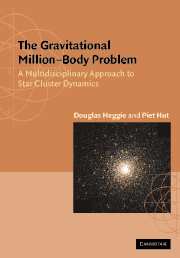Book contents
- Frontmatter
- Contents
- Preface
- PART I INTRODUCTIONS
- 1 Astrophysics Introduction
- 2 Theoretical Physics Introduction
- 3 Computational Physics Introduction
- 4 Mathematical Introduction
- PART II THE CONTINUUM LIMIT: N → ∞
- PART III MEAN FIELD DYNAMICS: N = 106
- PART IV MICROPHYSICS: N = 2
- PART V GRAVOTHERMODYNAMICS: N = 106
- PART VI GRAVITATIONAL SCATTERING: N = 3
- PART VII PRIMORDIAL BINARIES: N = 4
- PART VIII POST-COLLAPSE EVOLUTION: N = 106
- PART IX STAR CLUSTER ECOLOGY
- Appendix A A Simple N-Body Integrator
- Appendix B Hints to Solution of Problems
- References
- Index
2 - Theoretical Physics Introduction
Published online by Cambridge University Press: 05 June 2012
- Frontmatter
- Contents
- Preface
- PART I INTRODUCTIONS
- 1 Astrophysics Introduction
- 2 Theoretical Physics Introduction
- 3 Computational Physics Introduction
- 4 Mathematical Introduction
- PART II THE CONTINUUM LIMIT: N → ∞
- PART III MEAN FIELD DYNAMICS: N = 106
- PART IV MICROPHYSICS: N = 2
- PART V GRAVOTHERMODYNAMICS: N = 106
- PART VI GRAVITATIONAL SCATTERING: N = 3
- PART VII PRIMORDIAL BINARIES: N = 4
- PART VIII POST-COLLAPSE EVOLUTION: N = 106
- PART IX STAR CLUSTER ECOLOGY
- Appendix A A Simple N-Body Integrator
- Appendix B Hints to Solution of Problems
- References
- Index
Summary
A single coupling constant
The gravitational N-body problem can be defined as the challenge to understand the motion of N point masses, acted upon by their mutual gravitational forces (Eq. (1.1)). From the physical point of view, a fundamental feature of these equations is the presence of only one coupling constant: the constant of gravitation, G = 6.67 × 10-8 cm3 g-1 s-2 (see Seife 2000 for recent measurements). It is even possible to remove this altogether by making a choice of units in which G = 1. Matters would be more complicated if there existed some length scale at which the gravitational interaction departed from the inverse square dependence on distance. Despite continuing efforts, no such behaviour has been found (Schwarzschild 2000).
The fact that a self-gravitating system of point masses is governed by a law with only one coupling constant (or none, after scaling) has important consequences. In contrast to most macroscopic systems, there is no decoupling of scales. We do not have at our disposal separate dials that can be set in order to study the behaviour of local and global aspects separately. As a consequence, the only real freedom we have, when modelling a self-gravitating system of point masses, is our choice of the value of the dimensionless number N, the number of particles in the system.
- Type
- Chapter
- Information
- The Gravitational Million–Body ProblemA Multidisciplinary Approach to Star Cluster Dynamics, pp. 14 - 22Publisher: Cambridge University PressPrint publication year: 2003



